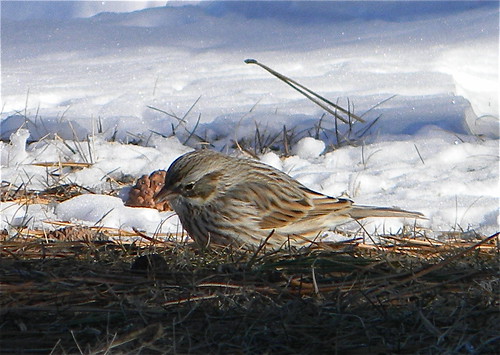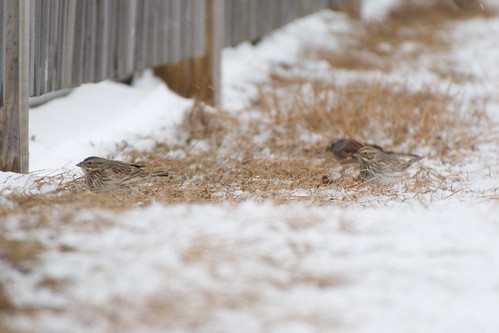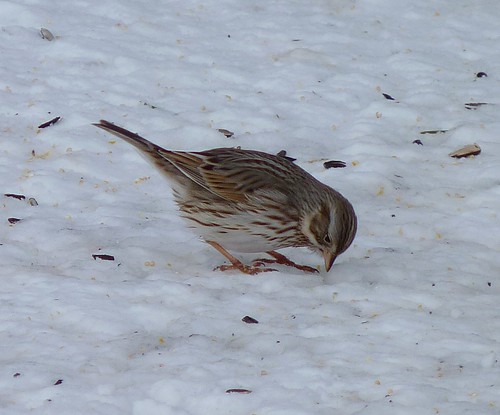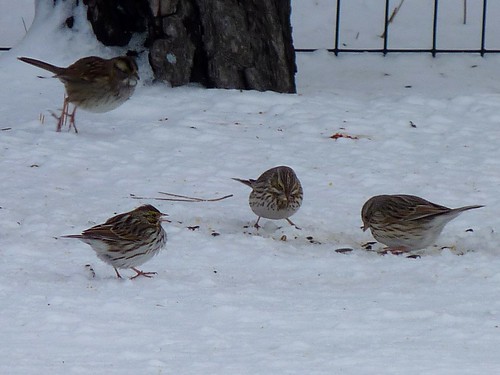
The white eye-ring and the pink bill; both these field marks suggest Vesper Sparrow.
Photo by Christian Nunes
Some of you may remember the post I put up in January of last year. This post described my dilemma after coming across a sparrow which bore such a resemblance to both a Song (SOSP) and a Savannah Sparrow (SAVS), and equally to a Vesper (VESP). It seemed at the time, and still does today, unidentifiable. Today I plan to return to this birds strange and quite mysterious features and see if I can shed some light on it.
At first glance this bird appears to be a Savannah Sparrow but on closer inspection the birds broad malar stripe and the lack of of yellow on the lores suggest that this bird is a Song Sparrow (although not all SAVS have yellow lores). Yet now we notice the dainty pink bill and the spotting at the base of the lateral throat-stripes (the lateral throat-stripes are squeezed tightly in between the malar and the throat). The throat-stripe is dark and unspotted at the base in the SOSP. Now I'm sure you're all as confused me.

Notice the broad, buff malar and the strange colored streaking on the underparts.
Photo by Christian Nunes
So far it sounds that it's more likely a SAVS yet we still have not ruled out the VESP. This species seems quite unlikely due to the season and its rareness in the general area. But despite these facts some field marks seem to fit this species well although while others work against it. The VESP is a large drab sparrow, usually found in pastures and fields, it's two identifying field marks are it's white outer tail feathers which flash when in flight and the rufous coloring on the lesser coverts, which is unmistakable when seen but unfortunately these feathers usually remain hidden. Seeing that neither the tail or the lesser coverts weren't easily visible they didn't help us much.
The eye-ring is large and very white, this suggests a VESP. The crown seems to be streaked heavily, although each streak is very light. Yet there is a greater number of field marks which rule out a VESP: the malar stripe doesn't seem to wrap around behind the cheek, the back half of the supercilium seems to light and broad, the streaking on the underparts seems far to dark and thick, and like the SOSP the lateral throat stripe is unspotted.

Notice the thin streaking on the crown also suggesting Vesper Sparrow.
Photo by Ben Shamgochian
Enter "Ipswich" Savannah Sparrow. The "Ipswich" Savannah Sparrow is a large very pale subspecies of SAVS which breeds only on Sable Island, Nova Scotia and Winters all along the East coast. Although those of you that have seen my photo may be wondering why I would be considering an "Ipswich" when the bird in my photo is so dark. I tend to think that the photo I took is too dark. When comparing my shot with my brothers photo of the same bird taken at the same time one finds the color difference shocking. Also some photos of the same bird were taken by Christian Nunes (which seem to be in between mine and my brothers photos lighting wise) and by some New Jersey birder (who I don't know the name of), both ID'd it as an "Ipswich".

Compared with the "Ipswich" Savannah Sparrow on the right hand side our bird appears much darker, and all around different.
Photo by Christian Nunes
Then there is always the possibility that this bird is a hybrid. Ten percent of all bird species hybridize, eight percent of these are Passerines. Sparrows do occasionally hybridize, most hybrids are usually derive from birds in the Zonotchrica genus, but there is always the remote possibility that one could stumble across a Savannah x Song, or a Song x Lincoln's or something along the general line. I must say that although this bird showed no field marks pertaining to Lincoln's, the latter of the two hybrids is far more likely, both species being in the genus Melospiza while the SAVS is in the genus Passerculus. Maybe the sparrow that would look most like this bird would be a Savannah x Vesper Sparrow. But that this bird is a hybrid seems unlikely.
There is one more option I haven't considered: a 1/2 hybrid. David Sibley says that “Ipswich” Savannah Sparrows will breed with the more common subspecies when they come in contact. Though James D. Rising (a SAVS expert) points out that their breeding ranges don't overlap.
A subspecies hybrid seems to me more likely to be seen in the wild then a full hybrid. Maybe this is what we saw.

Photo by the NJ birder.
But without more information we probably wont be able to positively ID it. DNA testing would have been nice. I should have remembered to take a feather sample to run through my tree house genetic research tree house laboratory - next time I won't forget! They actually did test the DNA of a rare Rufous Hummingbird in Illinois, for identification purposes. Ref. Winging It Vol. 24, No. 1, February 2012, pg. 1).
Hopefully this post will restart the discussion on its identity that ended months ago. I love a good on-line bicker.

From left to right White-throated (upper left), Savannah (regular), "Ipswich" Savannah and the strange sparrow.
Photo by the NJ birder
Tell me what you think of this bird in the comments section of this post, I look forward to reading your replies!






















